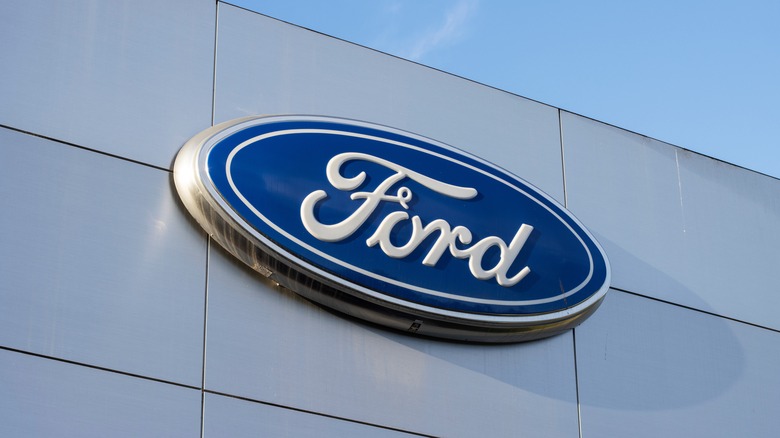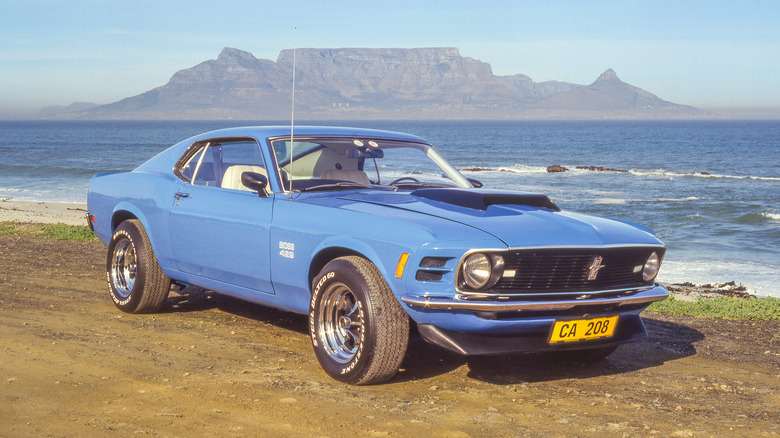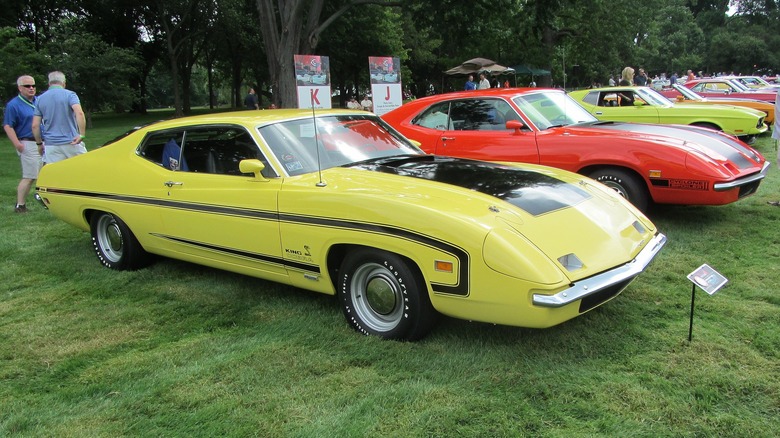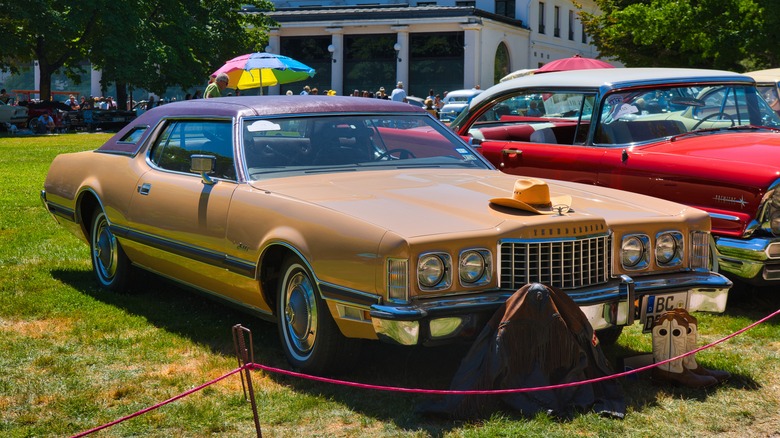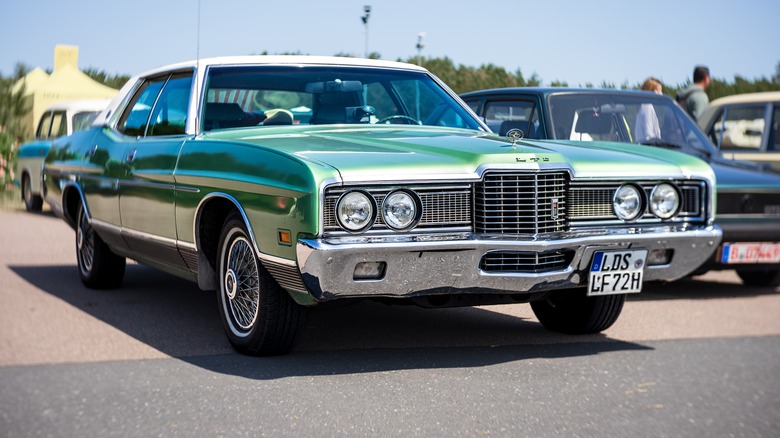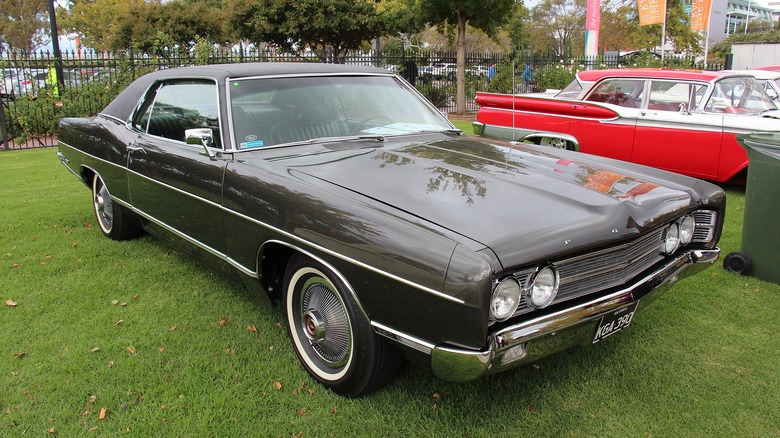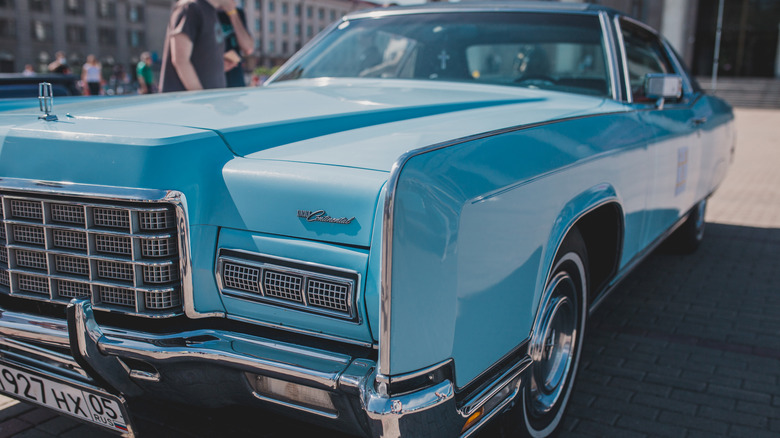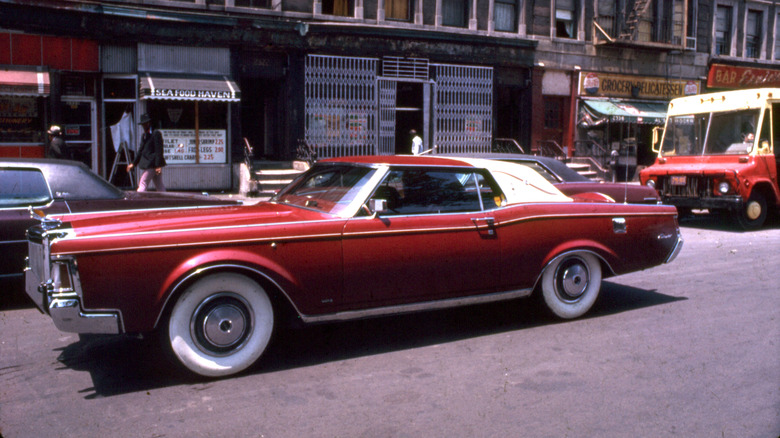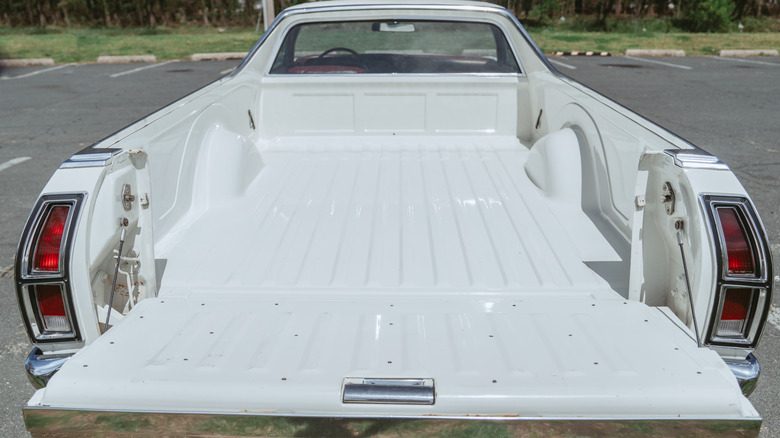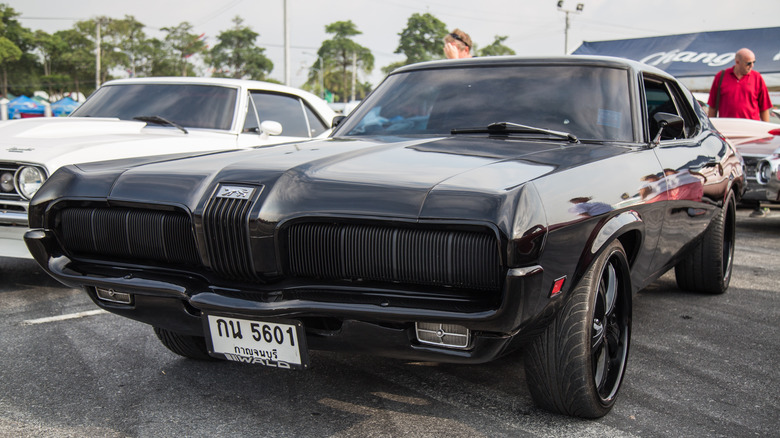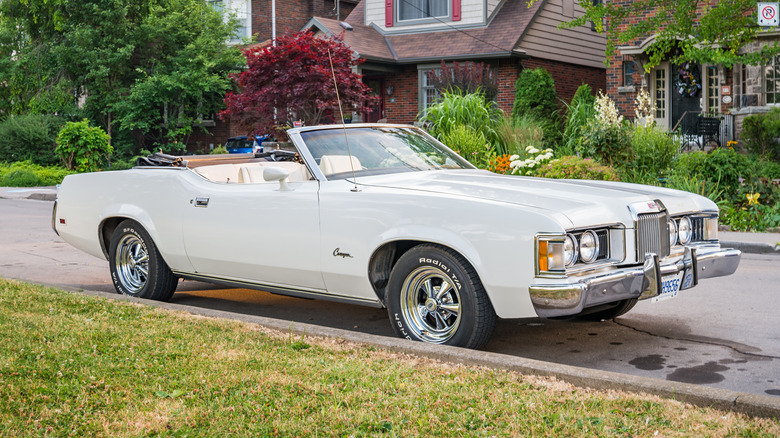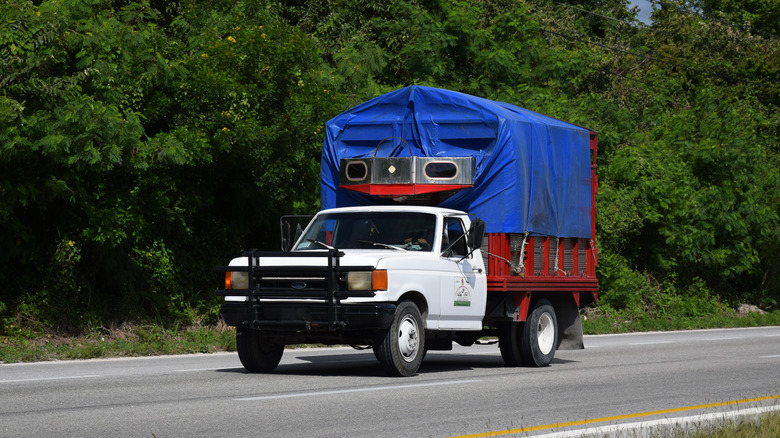Every Ford Model Powered By The 385 Series V8 Engine
The Ford 385 Series V8 engine, also known as the "Lima" engine by many automotive enthusiasts, is a big-block powerplant that Ford designed and manufactured from 1968 through 1997. Produced in 370-cubic inch, 429-cubic inch, and 460-cubic inch displacements, this engine family traces its name to the 3.85-inch crankshaft stroke of the original 460 V8.
Over its nearly three decades of service, the 385 Series V8 engine evolved quite a bit. It could be found under the hoods of everything from sleek Thunderbirds to workhorse Econoline vans and F-Series pickup trucks. In 1982, the 429-cubic inch version replaced the 401, 477, and 534 engines in trucks, while the smaller 370-cubic inch model took over for the 361 FE in 1978. These engines served as the standard power option in Ford's sturdy full-size trucks for many years. Here are all the impressive Ford models that benefited from the robust force of the legendary 385 series V8.
1969-1970 Mustang Boss 429
The 1969-1970 Ford Mustang Boss 429 was a high-performance variant of the popular Ford Mustang sports car engineered specifically for racing homologation in NASCAR. To power the Boss 429, Ford developed its new 385 Series 429-cubic-inch V8 engine — one of the most impressive powerplants in a Mustang ever.
Featuring prominent modifications like four-bolt main caps, a forged steel crankshaft and connecting rods, unique aluminum cylinder heads with angled valves and a semi-hemispherical combustion chamber design, the 385 Series engine was optimized to maximize power output. It was mated to an aluminum intake manifold and a Holley four-barrel carburetor.
Initially, the Mustang's stock engine compartment was simply not wide enough to fit this massive engine. So Ford contracted with Kar Kraft of Dearborn, Michigan, to modify the engine bay and compartment on the Boss 429 and create enough room for the formidable 385 Series V8.
The 1970 model year also brought a major face lift. Gone were the distinctive four headlights of 1969, replaced by a sleeker two-lamp design, and some exterior styling touches were made subtler. The noticeable hood scoop was de-emphasized a bit, and the side vents just behind the door handles got the axe.
Despite the impressive performance capabilities the 385 Series, surprisingly few Boss 429 Mustangs were ever produced — just 1,360 — over the two model years. This extremely limited production run has made the Boss 429 one of the most coveted and valuable Mustangs in existence today.
1970 Ford Torino King Cobra
The 1970 Ford Torino King Cobra was meant to take on the Dodge Charger Daytona and Plymouth Superbird in the NASCAR racing series. Aerodynamics was a big focus in its design since it was made specifically for racing. This gave it a really unique look with a long hood that tapered to a point and a smooth, sloping nose. It never actually went into production, though, because of changes to NASCAR's homologation rules and some executive shakeups at Ford.
Only three prototypes ever built, and in 2017 a Ford Torino King Cobra was listed on eBay asking a cool $459,000! The inside is surprisingly basic, featuring vinyl-covered bench seats and a Hurst T-shaped gearshift. But under the hood, it had a big 7.0-liter V8 engine pumping out around 370 hp, shooting that power to the back wheels through an automatic transmission. The other two prototypes are said to have been snatched up by racing team owner Bud Moore for a grand total of $1,200 back in the day.
1972-1976 Ford Thunderbird
The sixth generation of the Ford Thunderbird debuted in 1972 and marked a significant shift from prior models. Growing ever larger, this generation weighed over 5,000 pounds and was the biggest Thunderbird yet. Externally, Ford simplified the body style to a single two-door hardtop model that shared many external components with the Continental Mark IV — the primary differences were in the front and rear body panels.
From 1972 to 1976, Ford gave the Thunderbird massive engines to shake up the industry. Buyers could choose between a 7.0-liter or 7.5-liter 385 V8 engine, each mated to a three-speed automatic transmission as standard. With the huge engines and doubled-rounded headlights framing a bold pinned-out grille, the Thunderbird truly looked like a battleship on wheels.
The luxurious interior was also shared with the Mark IV but featured Thunderbird-specific details like round dials for the speedometer, clock, and fuel gauge. Leather seats, automatic climate control, a mini stereo, and power windows all came standard, and an available sunroof added to the opulence.
An awesome lowrider vehicle, the 1973 Thunderbird was one of the most commercially successful cars that year, with over 87,000 units sold.
1969-1978 Ford LTD
The Ford LTD from the late 1960s to the late 1970s knew how to strike the perfect balance between affordability and luxury for the average worker. With its sleek styling and impressive features, the LTD readily took on popular rivals like the Chevy Caprice, Dodge Monaco, and Plymouth Fury III.
Over the years, this LTD generation has only looked better, with a longer wheelbase and different body styles — you could get it as a hardtop, sedan, coupe, convertible, or the extra spacious Country Squire wagon. The 1969 debut featured those wild hideaway headlights, and the interiors offered classic American comfort with plush vinyl and plastic throughout — all at a very fair price point.
By 1973, Ford gave the LTD some extra toughness with 5-mph bumpers on the front and rear. Under the hood, you had your choice of the stalwart 351 and 400-cubic inch V8 engines. Then, in '74, those wanting even more kick could opt for the mighty 460 V8 instead. A few years later, in '76, improvements like four-wheel disc brakes and an 8-track player became available too — perfect for music lovers and those wanting better stopping power.
1969-1974 Ford Galaxie
The Galaxie was a classic, affordable full-size Ford car from 1959 to 1974. In the early years from 1959 to 1961, the car represented Ford's top-of-the-line model, capitalizing on all the excitement around the Space Race at the time. In 1965 the Galaxie got a revamp with a sleeker look and stacked headlights up front, along with an updated suspension setup, and successive updates really let it stand out as Ford's plush full-sizer.
The later 1969 to 1974 models saw an all-new chassis and longer 121-inch wheelbase. It was during these years that Ford's new 385 series V8 engines made their debut, too. Some notable engine options included the 302, 351, 390, 400, 429, and 460 V8s. This generation did away with the "XL" designation and received minor yearly styling tweaks until 1974, when the Galaxie name was retired in favor of the LTD.
Over the Galaxie's entire 15-year production run, Ford and its Mercury counterpart sold an impressive total of around 7.85 million full-size cars. That puts it as the second best-selling Ford of all time, just behind the iconic Model T. It was certainly one of the best affordable family haulers of its day.
1968-1978 Lincoln Continental
The 1968 Lincoln Continental was a pretty unique ride. Not only was it one of the final four-door convertibles available in the U.S., but it also had those old-school "rear-hinged" that opened from the middle. Its low-slung, long-hood style is hugely influential for upscale automakers even today. Under the hood was a massive 460-cubic inch V8 packing 365 hp, along with 500 lb-ft of torque twisting the tires. This muscle was paired with a three-speed automatic transmission called the Select-Shift Turbo-Drive to put that power to the pavement.
Available as either a four-door sedan or two-door coupe, the '68 Continental came loaded with various comfort and convenience features, offering a luxurious driving experience. It had power windows, power front disc brakes, power steering, automatic parking brake release, and a well-appointed heating and ventilation system. The interior also featured power-adjustable front seats, interior courtesy lights, and plush upholstery padded with 5.5 inches of material and deep-dyed leather.
Further indulgences included options like a six-way power bench seat for luxurious adjustability, tinted glass for privacy, a limited-slip differential for improved control, and speed control for relaxed cruising.
1969-1979 Lincoln Mark III, IV, and V
Back in 1965, Ford president Lee Iacocca wanted Lincoln to have a truly luxurious new model. He tasked Gene Bordinat with designing a car with a fancy grille like a Rolls Royce, who came up with the 1968 Lincoln Continental Mark III. Introduced for the 1969 model year, the Mark III was around through 1971 and borrowed some style cues from the Ford Thunderbird while still looking distinct.
Riding on the success of the Mark III, Lincoln launched the Mark IV in 1972. It shared the longer platform of the Thunderbird and kept signature design elements from its predecessor like the grille and that cool bump on the trunk, though the car was longer and wider. It also debuted optional small oval "opera windows" in the back of the roof, which became standard the following year in 1973.
In 1977, Lincoln came out with the totally revamped Continental Mark V. Gone was the rounded styling of the previous Mark IV — this one had sharper edges and straight lines for a more angular look. While the interior design stayed similar, the Mark V was even bigger, at over 19 feet long. The standard 460-cubic-inch V8 engine got replaced by a slightly smaller 400 V8, but you could still get the bigger 460 through 1978. Production of the Mark V wrapped up in 1979 with the launch of the smaller Mark VI, which dropped the iconic 460 and went with the 302 and 351 Ford engines instead.
Even though prices for the Mark V were really steep back then, it was clearly a hit with buyers. It sold around 75,000 units each year, and it was in production over those three years.
1969-1978 Mercury Marquis
The 1969-1978 Mercury Marquis cruised down the road, powered mainly by Ford's big 5.8-liter V8. This engine was matched up to a three-speed automatic transmission that delivered plenty of toe for such a large sedan. And if you wanted something bigger, larger optional V8s — 6.6-liter, 7.0-liter, and 7.5-liter — were available, too.
As the years went by, the Marquis lineup got some nice upgrades, especially the 1977 and 1978 models. New trim levels were introduced, adding a touch more luxury and style to an already impressive collection. The Brougham, for one, was an ultra-plush model with Landau vinyl roofs and fancy interior materials, ensuring one smooth and comfy ride.
At the very top of the Marquis family was the Grand Marquis, Mercury's full-size flagship. This bad boy had all the bells and whistles. Tinted windows kept things private and cozy, while dual dome lights brightened things up inside. A digital clock, high tech for its day, brought a modern flair to the interior. All in all, the Grand Marquis had everything you could want and more.
1970-1976 Ford Ranchero
The Ranchero is a classic Ford vehicle that deserves a modern comeback, offering a unique blend of truck utility with sporty car styling. The 1970 model, in particular, offered impressive power and performance options. There were four main versions available based on the popular Ford Torino: the Ranchero Squire luxury pickup, the sporty Ranchero GT, the more basic Ranchero 500, and a base model.
The Ranchero GT stood out as the performance-focused option. It featured a laser color stripe down the sides and a rear tailgate for visual flair. Under the hood was a standard 220 hp 302 V8 for plenty of grunt. You could upgrade to a 250 hp or 300 hp 351 Cleveland, or even go all out with one of three versions of the legendary 429 big-block — the 360 hp Thunder Jet, 370 hp Cobra Jet, or the ultimate upgrade, the 375 hp Super Cobra Jet.
All versions, except the base, could be upgraded with optional hidden headlights for a sleek look. The Squire, 500, and base model came standard with a 250 cubic-inch six-cylinder engine generating around 155 hp. Ford kept making the Ranchero through 1979, with about 508,355 buyers grabbing one over the years. The model seemed to really hit its stride in 1972 and 1973, with 40,334 and 45,741 units sold respectively during those seasons.
1969-1970 Mercury Cougar Eliminator
The 1970 Mercury Cougar Eliminator was as one of Mercury Cougar's standout performance models during the pivotal muscle car era of 1969-1970. The Eliminator option added substantial performance features both inside and out. Exterior modifications like a black front grille, hood scoop, and rear wing lent an aggressive stance with a simple yet distinctive black stripe package and "Eliminator" badging. It was further indulged with stylish steel wheels, AM/FM stereo, and sporty interior accents.
Under the hood, the base engine was initially a high-revving 351 Windsor V8, but an even mightier 351 Cleveland replaced it as the standard powerplant for 1970. The top-of-the-line Eliminator exclusively offered the Boss 302 option, sharing its kick-butt 4.9-liter V8 with the legendary Mustang. Or you could go all out with the mighty 7.0-liter Cobra Jet 428. Two rare special-order units — featuring the legendary Boss 429 engine — were also built, with one going to drag racer "Dyno" Don Nicholson.
Despite possessing the potent attributes of a premier muscle car, the Mercury Cougar Eliminator wasn't present in sufficient quantities in showrooms or out on the roads to achieve wider recognition during its time. It has arguably remained one of the most underappreciated Mercury muscle cars.
1971-1976 Mercury Cougar
The Mercury Cougar outperformed expectations when it hit the scene in 1967 as a fancier alternative to the classic Ford Mustang. Even with the base V8 churning out a decent 195 horsepower, those early Cougars could really fly when you put the pedal down.
In 1971, the Cougar entered its second generation (lasting through '73) with some major changes both inside and out. Under the hood, the standard engine was now a 351 Cleveland V8 cranking out a healthy 240 horsepower. But Mercury offered customers an option for even more punch — a high-performance four-barrel version of that V8. While two legendary engines, the Boss 302 and Boss 429, were no longer available, the top-of-the-line 429 Cobra Jet V8 delivered a stout 370 horsepower.
Some key changes in this generation included new styling cues alongside a stretched a little longer on the new 112-inch wheelbase for more legroom. This established the Cougar as a distinctive yet still performance-oriented luxury pony car. By the third generation (1974- 1976) the Cougar had evolved further into a premium hardtop coupe, with the XR-7 as its only available trim.
1973-1997 F-Series Trucks and E-Series Vans
The 385-series 460 cubic inch V8 engine was quite the workhorse for Ford from the 1970s all the way through the 1990s. Ford first offered it as an option in 1974 F-Series trucks, and it would power everything from the lighter F-100s up to the heavier-duty F-350s. The intermediate 429 cubic inch V8 was also an option in the medium-duty F-600 and F-700 pickups.
The Econoline vans, also known as the E-Series, used the 460 V8 extensively. The 1975 redesign of the Econoline, which introduced a longer front end look (the familiar ong-nose face), also expanded interior space and made them more accessible for ambulances, cargo vans, and other commercial variations. This new generation offered more engine options, including the 460 V8 alongside the 302 and 351 Windsor V8s.
As the years went by, Ford kept improving the 460. In 1988, it added fuel injection, which boosted power and fuel efficiency. It just kept chugging along very reliably in all kinds of work vehicles for Ford.
